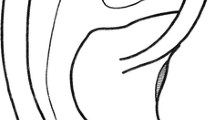Abstract
Acupuncture using laser needles is a new totally painless stimulation method which has been described for the first time. This paper presents an experimental double-blind study in acupuncture research in healthy volunteers using a new optical stimulation method. We investigated 18 healthy volunteers (mean age±SD: 25.4±4.3 years; range: 21–30 years; 11 female, 7 male) in a randomized controlled cross-over trial using functional multidirectional transcranial ultrasound Doppler sonography (fTCD; n=17) and performed functional magnetic resonance imaging (fMRI) in one volunteer. Stimulation of vision-related acupoints resulted in an increase of mean blood flow velocity in the posterior cerebral artery measured by fTCD [before stimulation (mean±SE): 42.2±2.5; during stimulation: 44.2±2.6; after stimulation: 42.3±2.4 cm/s, n.s.]. Mean blood flow velocity in the middle cerebral artery decreased insignificantly. Significant changes (p<0.05) of brain activity were demonstrated in the occipital and frontal gyrus by fMRI. Optical stimulation using properly adjusted laser needles has the advantage that the stimulation cannot be felt by the patient (painless and no tactile stimulation) and the operator may also be unaware of whether the stimulation system is active. Therefore true double-blind studies in acupuncture research can be performed.





Similar content being viewed by others
References
Litscher G, Schikora D (2002) Cerebral vascular effects of non-invasive laserneedles measured by transorbital and transtemporal Doppler sonography. Lasers Med Sci 17:289–295
Litscher G, Schikora D (2002) Near-infrared spectroscopy for objectifying cerebral effects of needle and laserneedle acupuncture. Spectroscopy 16:335–342
Aaslid R (1987) Visually evoked dynamic blood flow response of the human cerebral circulation. Stroke 18(4):771–775
Sturzenegger M, Newell DW, Aaslid R (1996) Visually evoked blood flow response assessed by simultaneous two-channel transcranial Doppler using flow velocity averaging. Stroke 27(12):2256–2261
Hui KKS, Liu J, Makris N, Gollub RL, Chen AJW, Moore CI, Kennedy DN, Rosen BR, Kwong KK (2000) Acupuncture modulates the limbic system and subcortical gray structures of the human brain: evidence from fMRI studies in normal subjects. Hum Brain Map 9:13–25
Li G, Cheung RTF, Ma QY, Yang ES (2003) Visual cortical activations on fMRI upon stimulation of the vision-implicated acupoints. Neuroreport 14:669–673
Cho ZH, Chung SC, Jones JP, Park JB, Park HJ, Lee HJ, Wong EK, Min BI (1998) New findings of the correlation between acupoints and corresponding brain cortices using functional MRI. Proc Natl Acad Sci USA 95:2670–2673
Cho ZH, Oleson TD, Alimi D, Niemtzow RC (2002) Acupuncture: the search for biologic evidence with functional magnetic resonance imaging and positron emission tomography techniques. J Altern Compl Med 8:399–401
Siedentopf CM, Golaszewski SM, Mottaghy FM, Ruff CC, Felber S, Schlager A (2002) Functional magnetic resonance imaging detects activation of the visual association cortex during laser acupuncture of the foot in humans. Neurosci Lett 327:53–56
Litscher G, Schikora D (2002) Effects of new noninvasive laserneedles on brain function. Proceedings of the International Federation for Medical and Biological Engineering 2:996–997
Litscher G (2002) Computer-based quantification of traditional Chinese-, ear- and Korean hand acupuncture: needle-induced changes of regional cerebral blood flow velocity. Neurol Res 24:377–380
Litscher G, Wang L, Wiesner-Zechmeister M (2000) Specific effects of laserpuncture on the cerebral circulation. Lasers Med Sci 15:57–62
Litscher G (2001) High-Tech Akupunktur. Pabst, Lengerich
Litscher G, Wang L, Yang NH, Schwarz G (1999) Computer-controlled acupuncture. Quantification and separation of specific effects. Neurol Res 21(6):530–534
Litscher G, Wang L, Yang NH, Schwarz G (1999) Ultrasound-monitored effects of acupuncture on brain and eye. Neurol Res 21(4):373–377
Litscher G, Yang NH, Schwarz G, Wang L (1999) Computer-controlled acupuncture. A new construction for simultaneous measurement of blood flow velocity of the supratrochlear and middle cerebral arteries. Biomed Techn 44(3):58–63
Litscher G, Schwarz G, Sandner-Kiesling A, Hadolt I (1998) Robotic transcranial Doppler sonography probes and acupuncture. Int J Neurosci 95(1–2):1–15
Litscher G, Schwarz G, Sandner-Kiesling A, Hadolt I, Eger E (1998) Effects of acupuncture on the oxygenation of cerebral tissue. Neurol Res Suppl 1:28–32
Litscher G, Wang L (2000) Cerebral near infrared spectroscopy and acupuncture - results of a pilot study. Biomed Technik 45(7–8):215–218
Bäcker M, Hammes MG, Valet M, Deppe M, Conrad B, Tölle TR, Dobos (2002) Different modes of manual acupuncture stimulation differentially modulate cerebral blood flow velocity, arterial blood pressure and heart rate in human subjects. Neurosci Lett 333:203–206
Litscher G (2003) Cerebral and peripheral effects of laserneedle-stimulation. Neurol Res 25:722–728
Lee H, Park HJ, Kim SA, Lee HJ, Kim MJ, Kim CJ, Chung JH, Lee H (2002) Acupuncture stimulation of the vision-related acupoint (Bl-67) increases c-Fos expression in the visual cortex of binocularly deprived rat pups. Am J Chin Med 30:379–385
Acknowledgements
The authors thank Eva Maria Huber (Department of Biomedical Engineering and Research in Anesthesia and Critical Care, Medical University of Graz, Austria), Martin Kronbichler (Department of Psychology, University of Salzburg, Austria) for supporting this study.
Author information
Authors and Affiliations
Corresponding author
Rights and permissions
About this article
Cite this article
Litscher, G., Rachbauer, D., Ropele, S. et al. Acupuncture using laser needles modulates brain function: first evidence from functional transcranial Doppler sonography and functional magnetic resonance imaging. Lasers Med Sci 19, 6–11 (2004). https://doi.org/10.1007/s10103-004-0291-0
Received:
Accepted:
Published:
Issue Date:
DOI: https://doi.org/10.1007/s10103-004-0291-0




